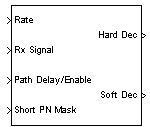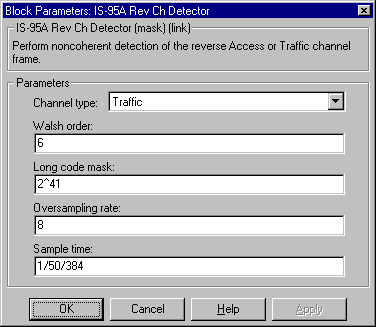| CDMA Reference Blockset |
  |
IS-95A Rev Ch Detector
Perform noncoherent detection of the input data frame
Library
IS-95A Base Station Receiver
Description

This masked hierarchical block performs finger-based despreading and noncoherent detection of the input data during the gate-on transmission time period. Note that the data at the output of the noncoherent rake finger are time aligned; as a result, the receiver combines the rake finger output data before the detection procedure. The rake receiver supports three fingers and provides both hard and soft output decisions.
In multirate cases (Traffic channels), where data transmission occurs in bursts, the block sends out zeros in the gate-off time slots. The data gate-on and gate-off times occur in accordance with the data burst randomization procedure specified in the IS-95A standard.
Inputs
- Rate
- Integer scalar that specifies the data rate for the input signal. To indicate a rate fraction of Full, Half, Quarter, or Eighth, use an input value of 0, 1, 2, or 3, respectively. The table below shows all valid channel types and rate fractions, along with their associated data rates and Rate input values.
Channel Type
|
Data Rate (bps)
|
Input Value
|
Access (always Half rate)
|
4800
|
1
|
Traffic, Rate Set I, Full
|
9600
|
0
|
Traffic, Rate Set I, Half
|
4800
|
1
|
Traffic, Rate Set I, Quarter
|
2400
|
2
|
Traffic, Rate Set I, Eighth
|
1200
|
3
|
Traffic, Rate Set II, Full
|
14400
|
0
|
Traffic, Rate Set II, Half
|
7200
|
1
|
Traffic, Rate Set II, Quarter
|
3600
|
2
|
Traffic, Rate Set II, Eighth
|
1800
|
3
|
- Rx Signal
- Complex vector representing the received data sequence. The vector size is the Oversampling rate parameter times the Walsh code length times the Input frame size parameter. The Walsh code length is 2W, where W is the Walsh order parameter. The default size, 512, corresponds to Oversampling rate = 8, Walsh order = 6 and Input frame size = 1.
- Path Delay/Enable
- Integer vector of size six comprising three pairs of integers. Each pair of integers is associated with a finger. The first element of the pair represents the PN phase offset, in number of input sample intervals, and the second element represents the finger enable signal. A value of one for finger enable enables the finger and a value of zero disables the finger.
- Short PN Mask
- Integer vector of size two representing the short PN code mask for the in-phase and quadrature components. The two elements represent a complex number whose real and imaginary parts are integers between 0 and 215-1. If a scalar value is given, then the in-phase and quadrature PN generators use the same mask. If the given mask is zero, then both in-phase and quadrature PN generators take the default value of 1.
Outputs
- Hard Dec
- Binary vector of size 576 representing the detected frame as hard decision values.
- Soft Dec
- Binary vector of size 576 representing the detected frame as soft decision values.
Dialog Box

Parameters
- Channel type
- The channel type, either Access or Traffic.
- Walsh order
- Integer scalar that specifies the order of the Walsh code used to encode each data symbol. The default value, 6, corresponds to a Walsh code length of 64.
- Long code mask
- Integer scalar that specifies the mask value for the long code generator. This parameter can be between 1 and 241-1.
- Oversampling rate
- Integer scalar that specifies the number of samples per chip. The default value, 8, corresponds to a chip interval.
- Sample time
- Real scalar that specifies the block output sample time.
Algorithm
For more about the rake receiver algorithm, see the Algorithm section on the reference page for the IS-95A Fwd Ch Detector block.
See Also
IS-95A Rev Ch Rake Finger
IS-95A Rev Ch Walsh Demodulator
IS-95A Reverse Traffic Channel Detection Demo
 | IS-95A Rev Ch Convolutional Encoder | | IS-95A Rev Ch Interleaver/Deinterleaver |  |






